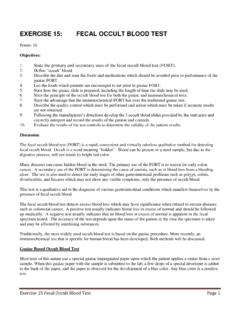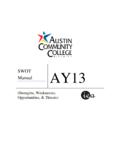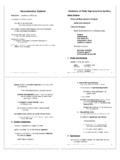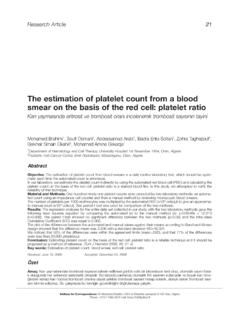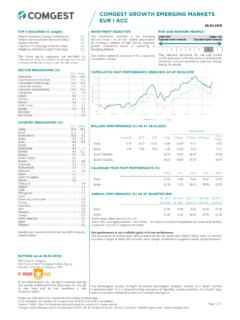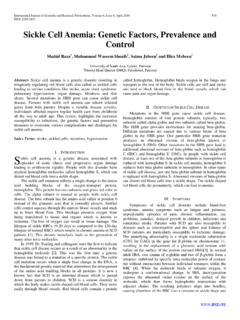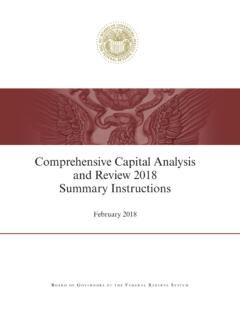Transcription of LABORATORY 3: Microscopic Urinalysis
1 LABORATORY 3: Microscopic Urinalysis Note Students are expected to review the corresponding information in the course textbook(s) as well as the classroom notes in preparation for this lab and to aid in answering the study questions. Points Points are awarded for Admission Tickets, Skills, including general lab requirements, as well as successful and timely completion of Study Questions. Objectives Upon completion of this LABORATORY exercise, the student will be able to: 1. perform Microscopic examinations on a minimum of ten urine specimens, obtaining results matching those of the instructor within 20% accuracy.
2 To meet this objective, the student must be able to identify RBCs, WBCs, squamous and renal epithelial cells as well as normal acid and alkaline crystals, mucous threads, bacteria and yeast at least 4 out of 5 times. At the instructor's discretion, microphotographs or electronic pictures may be used to aid in evaluation. In the evaluation of quantity, the student's results must match that of the instructor's reporting unit. 2. recognize and bring to the instructor's attention any abnormal / unexpected results including fatty, cellular, or waxy casts, abnormal crystalline structures, oval fat bodies, fat globules, trichomonas, etc.
3 3. use appropriate recording format to report results. 4. analyze control results to determine quality control acceptability. Equipment and Supplies 1. Urine specimens 2. Centrifuge tubes racks, marking pencils, Kim-wipes, microscope slides and cover glasses. 3. Centrifuge, Refractometer 4. Microscope 5. Color reference pictures of urinary sediment Supplemental References McBride, (1998). Textbook of Urinalysis and Body Fluids. Lippincott. Strasinger, S. K. & Di Lorenzo, , (2001). Urinalysis and Body Fluids, Chapter 6. Estridge, etal. (2000) Basic Medical LABORATORY Techniques, pp. 36-371. Ringsrud, K.
4 M. & Linne, J. J., (1995). Urinalysis and Body Fluids A Color Text and Atlas Chapters 5 & 6. MLAB 1311 Lecture and Lab Guides and the required course textbook(s). Web resources Overview 1. After the urine sample has been evaluated visually and chemically, a portion of the well mixed sample it is centrifuged and the sediment' evaluated microscopically to identify insoluble materials including formed elements such as blood cells, epithelial cells, bacteria and other parasites, crystals, casts and mucous. 2. At one time, Microscopic examination of the urine sediment was routinely performed as part of each Urinalysis ordered.
5 This phase of the Urinalysis testing is the most time consuming and may not provide much, if any, diagnostic information. Therefore as a means of making the UA test more cost effective, the Microscopic examination is no longer performed unless warranted. The process of determining whether a urine would be selected to undergo Microscopic examination is referred to as macroscopic screening' or chemical sieving'. When a specimen meets specific criteria during the physical or chemical testing phase, a Microscopic evaluation is warranted. Some laboratories call this a reflex Microscopic '. The goal is to be sure that urines with significant physical or chemical findings are viewed microscopically.
6 1. MLAB 1311 UA/BF LABORATORY Exercise 3. Revised 8/17/2015. Correlating results When the Microscopic is performed, its results should be correlated with the findings of the physical /chemical testing results. Although exceptions occur, the following are common examples: 1. Urine that is red in color - hazy to cloudy and has positive blood should demonstrate the presence of RBCs under the microscope. 2. Urine that is hazy to cloudy may have positive protein, leukocyte esterase and nitrites; may see WBC. and bacteria. 3. Increased turbidity in a refrigerated urine sample often means the presence of crystals.
7 4. Increased bacteria and presence of yeast are Microscopic elements often seen in diabetic patients. Note: the sample from a diabetic patient also often has positive glucose, ketones and a low pH. There are many possible reasons that a specimen's physical and chemical characteristics do not correlate with the Microscopic results. Among the first thing to be considered is a mix-up in samples - where the Microscopic was not performed on the same sample as the physical and/or chemical analysis. Another possibility to consider is deterioration in the sample. This is most commonly seen when there is a significant lag period between the different phases of testing or if the sample is very alkaline.
8 Regardless of the reason, the best course of action is to recollect the sample and repeat the testing ASAP. Remember, correlating results of the physical, chemical and Microscopic examination of the urine is an important part of UA quality control. More information on correlation of physical/chemical results with expected Microscopic analysis can be found in your textbook and other resources. Principles & Related Information The formed elements suspended in the urine are concentrated by centrifugation and analyzed under the microscope. Careful interpretation of the findings observed in examination of the urine sediment can provide rather accurate localizing information of pathologic processes in the urinary tract, or on occasion, point to a specific diagnosis of clinical problem.
9 Normal urine sediment contains a limited number of formed elements including: 1-2 RBC. Few WBC. Few epithelial cells (squamous epithelial cells are most frequently identified, especially in females, they originate from the linings of the genitourinary system). Occasional hyaline cast In performing a Microscopic examination of the urine, at least 10-15 fields of vision should be examined and averaged to enumerate each cellular element. This method is only a semi-quantitative method, but generally provides enough information to satisfy diagnostic needs. Urine Stains Some laboratories routinely use one or more stains to enhance visualization of the urine sediment.
10 The most commonly used urine sediment stains are commercial preparations of a supravital stain developed by R. Sternheimer & B. Malbin. The basic ingredients of the Sternheimer - Malbin stain are crystal violet and safranin O in ethyl alcohol. Commercially prepared variations of this stain have added stabilizers to limit precipitation. KOVA Stain and Sedi-Stain are two such examples. Review Urine Microscopic Examination PowerPoint and textbook for information on additional stains used when examining urine sediment. 2. MLAB 1311 UA/BF LABORATORY Exercise 3. Revised 8/17/2015. PROCEDURE. Preparation of Slide for Microscopic Examination *1.


